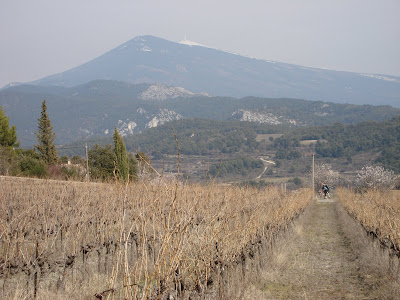
Up in the hills surrounding the Mont Ventoux, that majestic mountain that so dominates the Vaucluse, is the castle town called Le Barroux. Dear friends have settled there and are now making their wine Clos de Trias in this ancient world. Marie Caroline, a young Frenchwoman from a wine-making family in Champagne is the dynamic wife of Even, a tall blond Viking born and raised in California, now transplanted to Europe. A shared dream and passion, and most definitely a shared labor of love unite them.
As Even mixes and matches and experiments in the cellar and amidst the vines, Marie-Caroline covers the bases behind the scenes. As Even improves his French, he leans heavily on his fiercely bright wife. And as the three small blond heads of their children swirl about the living room and kitchen, the two come together to create, develop, raise, educate and pursue a most special path.

I was there the other day to discuss helping them distribute and import their wines to the US. In fact, they've so much knowledge between them, that much of what passed between us the other day was to my advantage. Even is a fount of information concerning marketing wine in the US, how it all works over there, who to trust, how to be sure to get paid, which markets to attempt entering, etc., Marie-Caroline is his equal on the French and European front.
However, why be at a winery if not to taste the wine and learn more about how it is made? Even is discovering the possibilities and potential of his vineyards -- averaging 42 years of age, with up to 65 and 75 year old vines in his vieilles vignes parcels. He is concurrently switching his vineyards to bio-dynamic viticulture and vinification.
As we tasted his most concentrated blend from 2007, rich in dark cocoa and spices, he expressed his conviction that he need not control temperature during fermentation, that the grape itself holds this knowledge within it. Depending on whether he is making his standard cuvée or his vieilles vignes, the fermentation lasts from 25 to 45 days. In either case a long period compared to most of his colleagues. And, from year to year, the temperatures spiked differently. 2008 was relatively cool -- just 25/26 degrees Celsius, while 2009 went all the way up to 35C. Compare this to many a vintner who carefully controls temperature to keep them around 18/20C for a white and no higher than 25/27 for a red...

As we tasted and contemplated, moving onto the 2009 grenache in a 300liter barrel of new oak with a bouquet of roses and flavors of candied strawberries, he noted that in fact, we were tasting on a root day. Oh? Yes, according to the bio-dynamic calendar, there are root, flower, leaf and fruit days. These cosmically influenced aspects affect our own palettes and thus our impression of the wines we taste, as well as affecting the wines. Ideally thus, try to schedule wine tastings on either a floral or fruit day (depending if you want to enhance the notes of violets and roses, or blackberry jam and fraises des bois). Fascinating, and worth some experimentation. Don't you agree?
He made me a vintner's special blend of his 2008, taking a certain amount from 3 different tanks (grenache, carignan and syrah, though he will also put a note of cinsault in the final blend). And this dark breuvage spoke to me of blackberry jam, dense, hints of sweetness and a full, round, chewy sensation in the mouth.
We spoke of his personal take on carbonic maceration -- a favored technique for the old vine carignan here, and one that JP also applies. However Even has information from an ancient text that suggests he pick his grapes and then let them sit in their bin in a cool area for 48 hours before putting half whole clusters and half de-stemmed grapes into the tank to ferment. Traditional carbonic maceration would put in only whole unpressed clusters, allowing a two time fermentation -- partially inside the skins, and then continued after pressing. But apparently, this latter requires adding carbon dioxide to protect the tank. Doing a half and half as Evan does allows those grapes that are pressed to create sufficient carbon dioxide to protect the whole clusters...

Experimenting is in his blood. As Even puts it, from one year to the next he'll test out anywhere from 6 to a dozen different possibilities. Having many small tanks permits this, as well as a cellar filled with 300 and 700 liter barrels. When back in California making wine for his former boss he would have up to 50 tests and experiments brewing in any given year. Can we say a passionate vintner?
What is fascinating is that the variables change from year to year, and as such, just because an experiment worked under the conditions of a certain year-- heat, sugar content, skin thickness, ripeness, etc., etc., -- it could turn out completely differently the following year. Thus the need to develop a certain sixth sense to what is possible.

As I savored the Christmas spices and dark plum jamminess of his Carignan I nodded and took careful notes. May his passion and drive continue!
1 comment:
Madeleine,
I used to work with Marie-Caroline in CA and would like to purchase their wine here. I presently live in FL. I will send you a Facebook Request.
Karri
Post a Comment